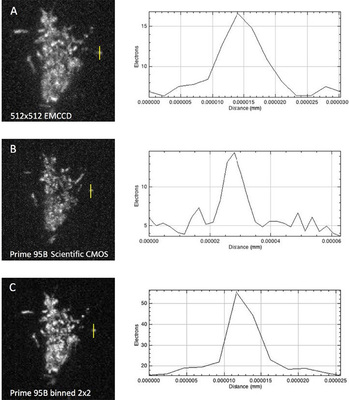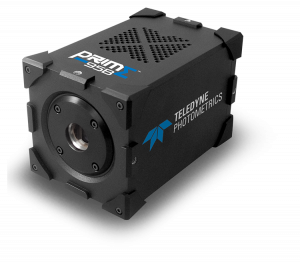Single Molecule TIRF
Dr. Aleks Ponjavic
Klenerman Group, University of Cambridge
Background
The Klenerman group at the University of Cambridge investigates intracellular signalling in T-cells, a vital component of the human adaptive immune response. They are particularly interested in the kinetic-segregation model of T-cell signalling which proposes that signalling is only possible when CD45 molecules on the T-cell surface are sterically excluded from the T-cell receptor site.
The group observes these cell-surface molecules using single molecule TIRF microscopy to add further structural support for the kinetic-segregation theory.

Jurkat T-cells bound to fibronectin. CD45 molecules on the cell surface labelled with Alexa 488.
A. Left: Maximum intensity projection of 500 frame 33 ms exposures taken with the Evolve Delta EMCCD camera using 250x EM gain. Right: Line profile taken through the marked area of the image (yellow line).
B. Left: Maximum intensity projection of 500 frame 33 ms exposures taken with the Prime 95B. Right: Line profile taken through the marked area of the image (yellow line).
C. Left: Maximum intensity projection of 500 frame 33 ms exposures taken with the Prime 95B binned 2×2. Right: Line profile taken through the marked area of the image (yellow line).
Cross section of a rabbit seminiferous tubule acquired using Dr. Hagen's structured illumination microscopy system and a Prime 95B camera with a 100X/1.47NA objective (top row) or 40x/1.3NA objective (bottom row). Images were reconstructed using SIMToolbox [2]. Conventional widefield fluorescence images (left) display out of focus light, raw SIM images (center) display the illumination pattern, and the 3D SIM reconstruction (maximum intensity projection, right) shows high quality, optically sectioned images.
Challenge
The group needs to ensure reliable detection of single molecules so high signal to noise is of great importance. To achieve this, they have been using the Photometrics Evolve® 512 EMCCD camera but made the decision to purchase a Prime 95B because of its high sensitivity combined with the multiple benefits of CMOS architecture. Aleks Ponjavic, postdoctoral researcher with the Klenerman group, told us, "I was very interested to compare the high sensitivity of the Prime 95B to an EMCCD for single molecule imaging."
I find the performance of the Prime 95B [Scientific CMOS camera] to be comparable to state-of-the-art EMCCDs
Dr. Aleks Ponjavic
Solution
When asked how the Prime 95B compared to an EMCCD camera, Aleks told us, "I find the performance of the Prime 95B to be comparable to state-of-the art EMCCDs but at lower cost and higher speed." He went on to say, "I would definitely choose the Prime 95B over an EMCCD for any high sensitivity application that would benefit from the high speed offered by a CMOS camera."

Learn More About the Prime 95B
Download This Customer Story